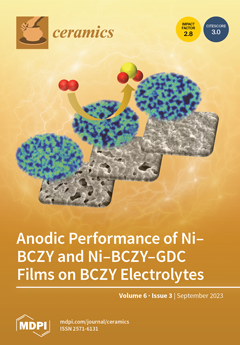Materials (cement stone samples) in the CaO-K
2O-SO
3-H
2O system with the target phase compositions, including syngenite K
2Ca(SO
4)
2·H
2O and calcium sulfate dihydrate CaSO
4·2H
2O, were prepared from powder
[...] Read more.
Materials (cement stone samples) in the CaO-K
2O-SO
3-H
2O system with the target phase compositions, including syngenite K
2Ca(SO
4)
2·H
2O and calcium sulfate dihydrate CaSO
4·2H
2O, were prepared from powder mixtures of calcium sulfate anhydrite CaSO
4, and/or calciolangbeinite K
2Ca
2(SO
4)
3, and potassium sulfate K
2SO
4 via hydration reactions at a water/powder ratio within an interval of 0.5–0.9. It was revealed that samples with contents of 25, 50, 75 and 100 mol% of syngenite K
2Ca(SO
4)
2·H
2O demonstrated a nonlinear dependence of their respective microstructures on their phase compositions. The microstructures of samples with phase compositions of 25 and 75 mol% of syngenite K
2Ca(SO
4)
2·H
2O consisted of pillar crystals. The microstructures of samples with phase compositions of 50 and 100 mol% of syngenite K
2Ca(SO
4)
2·H
2O consisted of plate crystals. An explanation of microstructure formation was set forth, taking into account equilibria of the dissolution–crystallization processes during cement stone formation. Materials obtained in the CaO-K
2O-SO
3-H
2O system consisting of biocompatible and resorbable (soluble in water) phases can be recommended for testing as potential substances for bone defect treatments.
Full article





